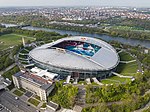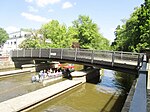Young Spectator's Theatre
Young Spectator's Theatre (Театр Юного Зрителя, ТЮЗ) was a standard name of a theatre for children and youth in many cities of the Soviet Union, usually referred to by this abbreviation: тюз, TYuZ (sometimes translated as "TUZ theatre"). The oldest children's theatre under such a name was Moscow TYuZ (Московский театр юного зрителя), created in 1918 and Bryantsev Youth Theatre in Saint Petersburg, opened in 1922. A TYuZ was typically a stationary theatre, with a dedicated building that housed several scenes, including a puppet theatre. While considered by many actors to be less prestigious than "adult" theatres, such theatres served well as entertainment for youth not yet sophisticated enough for more mature theatre.
Excerpt from the Wikipedia article Young Spectator's Theatre (License: CC BY-SA 3.0, Authors).Young Spectator's Theatre
Lindenauer Markt, Leipzig Altlindenau (Altwest)
Geographical coordinates (GPS) Address Website Nearby Places Show on map
Geographical coordinates (GPS)
| Latitude | Longitude |
|---|---|
| N 51.3378 ° | E 12.3333 ° |
Address
PAN
Lindenauer Markt
04177 Leipzig, Altlindenau (Altwest)
Saxony, Germany
Open on Google Maps









